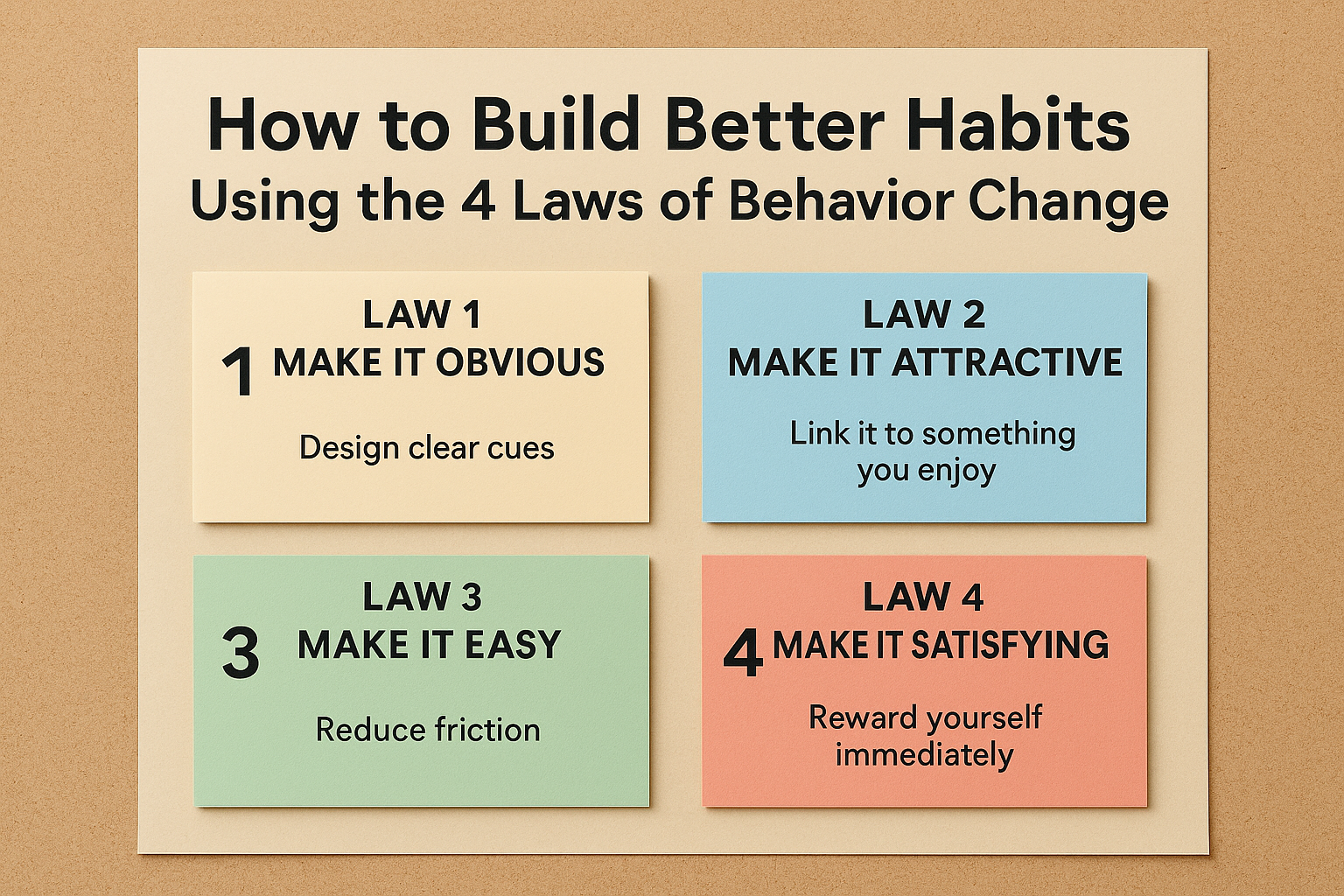Most people try to build new habits using willpower alone—but willpower is unreliable. The secret to lasting change is design: creating an environment and system that makes good habits easier and bad ones harder.
In this article, we’ll break down the 4 Laws of Behavior Change, based on James Clear’s Atomic Habits, and show you how to apply them in your daily life.
Why Habits Matter More Than Goals
Goals set the direction. Habits determine the progress.
While goals are important, they’re only achieved through consistent action. And that action comes from habits—small behaviors repeated regularly over time.
If you want lasting results in any area (health, productivity, mindset), you need to focus on building systems, not just chasing outcomes.
The 4 Laws of Behavior Change (Overview)
To build a habit, your brain follows a loop:
- Cue – What triggers the behavior
- Craving – The desire or motivation
- Response – The actual action or habit
- Reward – The benefit you get from doing it
The 4 Laws are based on this loop, and here’s how they work:
| Law | Strategy |
|---|---|
| 1. Make it obvious | Design clear cues |
| 2. Make it attractive | Link it to something you enjoy |
| 3. Make it easy | Reduce friction |
| 4. Make it satisfying | Reward yourself immediately |
Let’s explore each law with examples and practical tips.
Law 1: Make It Obvious
If you want to build a new habit, you need to clearly define it and place visual reminders in your environment.
Tips:
- Use habit stacking:
“After I [current habit], I will [new habit].”
Example: After I brush my teeth, I will meditate for 2 minutes. - Place cues where you’ll see them:
- Want to drink more water? Put a full glass on your desk.
- Want to read more? Leave a book on your pillow.
- Be specific:
Instead of “exercise more,” write “do 10 pushups after lunch.”
Clarity makes habits easier to follow and harder to ignore.
Law 2: Make It Attractive
We’re more likely to repeat behaviors that feel enjoyable or rewarding. To make a habit stick, associate it with something positive.
Tips:
- Pair your habit with something fun (temptation bundling):
“I’ll only watch my favorite show while on the treadmill.” - Surround yourself with people who have the habit you want. Behavior is contagious.
- Use affirmations or visualizations that reinforce your identity:
“I’m someone who takes care of their health.”
The more attractive the habit feels, the less resistance you’ll have.
Law 3: Make It Easy
Don’t aim for perfect—aim for repeatable. Success comes from showing up, not from doing something huge.
Tips:
- Start small:
- Meditate for 1 minute
- Write one sentence
- Do one pushup
This removes the friction of starting.
- Prepare your environment:
- Lay out your workout clothes
- Pre-cut veggies for meals
- Keep your guitar in plain sight
- Reduce steps between you and the action. The easier it is, the more often you’ll do it.
Consistency > intensity.
Law 4: Make It Satisfying
Your brain learns from rewards. If a habit feels good, you’re more likely to repeat it.
Tips:
- Use a habit tracker: Crossing off a day gives instant satisfaction.
- Celebrate tiny wins: Smile, say “I did it!”, or treat yourself to something healthy.
- Create streaks: The longer your streak, the more motivated you’ll be to keep it going.
Avoid habits that only feel good later (like saving money) by pairing them with something that feels good now (like a celebratory message or visual progress).
Final Thought: Systems, Not Just Goals
Building better habits isn’t about changing who you are overnight—it’s about becoming a better version of yourself each day.
Use the 4 Laws to shape your environment and mindset:
- Make it obvious
- Make it attractive
- Make it easy
- Make it satisfying
Start with just one habit. Apply the system. Watch it stick.
Because when your habits align with who you want to become, success becomes automatic.

